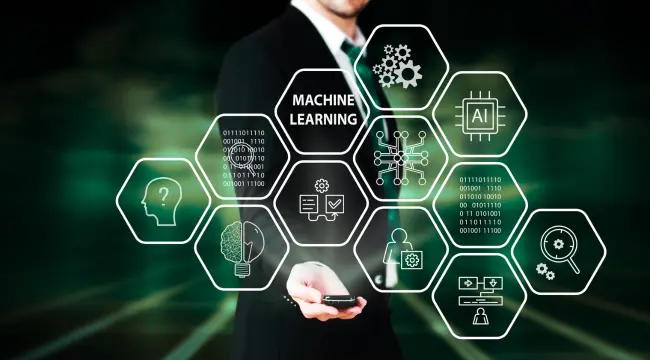So, now we are clear on what machine learning is, along with the benefits and drawbacks it wields— if you missed our last blog, Understanding what is Machine Learning: Basics, Pros, and Cons, go check it out now.
However, like handling every technology often many beginners stumble upon some challenges in machine learning too— but don’t you worry! By the end of this blog, you will be well equipped to handle challenges in machine learning and succeed with excellence.
Get ready to welcome a successful machine learning journey!

Similarly, adding poor-quality data, like inconsistent, incomplete, or biased datasets, in machine learning will eventually lead to unreliable predictions, making it hard to deploy accurate models!
So, what to do now?
Underfitting data: Here, the model does not train enough on the training data or is too simple to capture the underlying patterns in the data. Hence, the model results in performing poorly not only on the training data but also on new and unseen data. So basically, overfitting of data happens when the model becomes too similar with the training data.Underfitting happens when the model is too simple to capture any patterns from the data.
Solution:
Solutions:
Performance bottleneck is when the machine learning pipeline becomes a limiting factor, eventually slowing down the overall performance of model. This is the aftermath of inefficient algorithms, slow hardware, or large datasets.
Solution:
Well, now you cannot just survive but also thrive in your machine learning journey— but wait! Are we missing something significant? Yes, we are. The cornerstone of a successful machine learning journey is choosing the right algorithm for your projects. So let us find out which machine learning algorithm is suitable for your project in our next blog!
For any queries contact us now.
However, like handling every technology often many beginners stumble upon some challenges in machine learning too— but don’t you worry! By the end of this blog, you will be well equipped to handle challenges in machine learning and succeed with excellence.
Get ready to welcome a successful machine learning journey!

Data Quality and Preprocessing Issues
Imagine you are baking a cake. Now, it does not matter how good of a baker you are, if you add wrong or stale ingredients then your cake would not turn out to be the outstanding cake you were anticipating.Similarly, adding poor-quality data, like inconsistent, incomplete, or biased datasets, in machine learning will eventually lead to unreliable predictions, making it hard to deploy accurate models!
So, what to do now?
- Data Cleaning: make use of imputation techniques as well as other methods to clean data like outlier detection, and normalization to refine raw data.
- Feature Engineering: choose or create features which are relevant to improve model performance.
- Data Augmentation: handle imbalanced datasets by generating synthetic data using data balancing techniques.
- Automated Data Pipelines: maintain consistency by implementing automated data collection and preprocessing.
Overfit and Underfit data
Overfitting data: It is when a model learns too much from the training data and memorizes every single detail. As a result, it becomes too similar with this data. Even though it performs well on the data it was trained, it cannot perform on new and unseen data as it loses its ability to adapt to anything different. It is like a student who is trying to prepare for a math’s test by memorizing an English past paper.Underfitting data: Here, the model does not train enough on the training data or is too simple to capture the underlying patterns in the data. Hence, the model results in performing poorly not only on the training data but also on new and unseen data. So basically, overfitting of data happens when the model becomes too similar with the training data.Underfitting happens when the model is too simple to capture any patterns from the data.
Solution:
- Regularization: reduce complexity by applying L1/L2 regularization.
- Cross-validation: make sure your model performs well by using k-fold cross-validation.
- Feature Selection: avoid unnecessary complexity by eliminating irrelevant features.
- Ensemble Methods: Combine multiple models (e.g., Random Forest, Gradient Boosting), this can help improve robustness.
Interpretability and Explainability
Many beginners find it difficult to understand complex models. Especially black-box models like deep learning can lack transparency making it hard to explain predictions to stakeholders.Solutions:
- SHAP and LIME: You can make use of Shapley Additive Explanations (SHAP) or Local Interpretable Model-agnostic Explanations (LIME). These are methods that can explain complex machine learning models.
- Decision Trees and Rule-Based Models: These models are more likely to be interpreted as they include straightforward logic which can be visualized and understood easily.
- Model Documentation: by maintaining clear documents it becomes easy to understand how decisions are being made.
Scalability and Performance Bottlenecks
While the models perform well on small datasets, they do not necessarily perform well on massive data sets as it takes a lot of time to train them or sometimes the training can fail too due to limitations in memory or computational power. This can overall affect the scalability of model.Performance bottleneck is when the machine learning pipeline becomes a limiting factor, eventually slowing down the overall performance of model. This is the aftermath of inefficient algorithms, slow hardware, or large datasets.
Solution:
- Distributed Computing: This refers to spreading the computation tasks across many screens to speed up the process. You can make use of frameworks like Apache Spark and TensorFlow.
- Efficient Algorithms: Choose algorithms which are efficient, especially for large datasets. Moreover, keep hyperparameters.
- Hardware Acceleration: For faster computation make use of GPUs and TPUs.
Model Deployment and Maintenance
Now it is time to finally deploy the model in real-world applications. However, deploying the model is quite challenging as it requires continuous monitoring and updates to see everything is going smoothly. Therefore, you should do this:- MLOps Practices: go for automated model deployment by implementing CI/CD pipelines.
- Monitoring and Logging: track model performance using tools like MLflow. Retraining Strategies: Maintain accuracy by updating the models with new data regularly.
Well, now you cannot just survive but also thrive in your machine learning journey— but wait! Are we missing something significant? Yes, we are. The cornerstone of a successful machine learning journey is choosing the right algorithm for your projects. So let us find out which machine learning algorithm is suitable for your project in our next blog!
For any queries contact us now.



